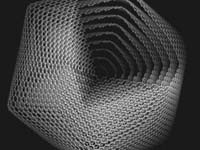
Diamonds are the hardest naturally occurring minerals known to man. Even so, scientists are working to make them even tougher, in order to use the sparkling gems as tools for cutting.
Diamonds are the hardest naturally occurring minerals known to man. Even so, scientists are working to make them even tougher, in order to use the sparkling gems as tools for cutting.
Now, a team of researchers led by Yongjun Tian and Quan Huang at Yanshan University in China, has created synthetic diamonds that are harder, meaning they are less prone to deformation and breaking, than both natural and other man-made diamonds.

To create these tougher-than-steel diamonds, the researchers used tiny particles of carbon, layered like onions, and subjected them to high temperatures and pressures. The resulting diamonds had a unique structure that makes them more resistant to pressure and allows them to tolerate more heat before they oxidize and turn to either gas (carbon dioxide and monoxide) or ordinary carbon, losing many of their unique diamond properties.
First, a bit about diamonds: Gem-quality diamonds are single crystals, and they are quite hard. But artificial diamonds used on tools are harder still. That's because they are polycrystalline diamonds, or aggregates of diamond grains called domains, that measure a few micrometers or nanometers across. The grains help to prevent the diamond from breaking, as the boundaries act like small walls that keep chunks of diamond in place. The smaller the domains are, the stronger the diamond.
The team also tested how hot the nanotwinned diamond could get before oxidizing. In two different tests, they found that the ordinary diamond began to oxidize at about 1,418 and 1,481 degrees Fahrenheit (770 and 805 degrees Celsius), depending on the testing method. The nanotwinned diamonds didn't oxidize until they reached 1,796 or 1,932 F (980 or 1,056C).
In addition, the novel part of the work is that such a hard material has been created in a way that can be readily reproduced. "They created a bulk material," Mao said. "They succeeded in making this and making it harder than diamond--that's novel."